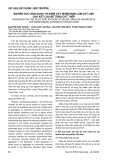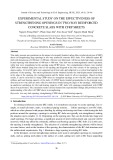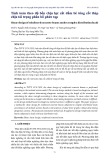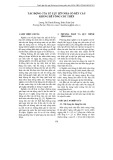
* Corresponding author.
E-mail addresses: h.r.ashrafi@razi.ac.ir (H. R. Ashrafi)
© 2016 Growing Science Ltd. All rights reserved.
doi: 10.5267/j.esm.2015.12.004
Engineering Solid Mechanics 4 (2016) 53-62
Contents lists available at GrowingScience
Engineering Solid Mechanics
homepage: www.GrowingScience.com/esm
Numerical study of shear wall behavior coupled with HPFRCC beam and diagonal
reinforcements
Hamid Reza Ashrafi* and Peyman Beiranvand
Technical & engineering faculty, Razi University, Kermanshah, Iran
A R T I C L E I N F O A B S T R A C T
Article history:
Received 6 September, 2015
Accepted 20 December 2015
Available online
21 December 2015
High performance fiber-reinforced cementitious composites (HPFRCC) are aggregates like
cement grout with fine grains and fibers which can be used in many cases like seismic
improvement of building components. One of these building components is connecting beam
in coupled shear wall which can increase plasticity and energy absorption. In this paper
nonlinear finite element model of coupled beam containing HPFRCC is analyzed and the
influence diagonal reinforcement is investigated on cracking patterns, stress contours and
hysteresis diagrams of shear wall. It was observed that diagonal reinforcements play
significant role in shear load bearing capacity of shear wall coupled with HPFRCC beam.
© 2016 Growing Science Ltd. All rights reserved.
Keywords:
Shear wall
Diagonal reinforcement
Nonlinear finite element
HPFRCC
1. Introduction
Conventional concretes made of Portland cement and natural grains have some shortcoming and
drawbacks, and hence specific concretes have been designed and innovated in recent years for reducing
such problems. In concrete technology, this class of concretes is called advanced concretes.
Conventional concretes usually have various capillary cracks and hence due to rapid development of
capillary cracks under imposed stresses, tensile strength of concrete materials is often low. The use of
fibers in concrete (i.e. constructing fiber concrete) is an effective way in prevention of micro and macro
cracks and increasing the concrete tensile strength. In recent years, significant developments have been
achieved for designing and manufacturing of fiber-reinforced cementituos composites (FRCC). Most
of the previous studies in this field are related to developments of grout, manufacturing different types
of fibers, grout-fiber interaction, composite production process, main mechanisms for controlling
behavior of FRCC composite and continuous improvement of executive costs. With more
developments in concrete technology, high-performance fibers was introduced. The term “high-
performance” refers to a specific class of fiber concretes which have strain hardening behavior under

54
stress after first cracking along with formation of multiple cracks and high strains. Using high-
performance aggregates instead of conventional aggregates is an interesting research subject and
various studies have been conducted in this field. These aggregates, in addition to increasing the
capacity of the structures against earthquake loads, can help the sustainability of the structures against
harmful environmental factors. One of these high-performance composites (which has significant
development in recent years), is high-performance fiber-reinforced cement composites (Parra-
Montesinos, 2005; Canbolat et al., 2005; Tran et al., 2014).
Concrete shear walls are one of the resistant systems against earthquake which are frequently used
due to their suitable performance in previous earthquakes. Because of using elevator in tall buildings,
shear walls located around the stairs should have openings. In this case, two shear walls (called coupled
shear walls or correlated walls) are designed with connecting beams. It is well understood that that
maximum shear stress in a bending beam with rectangular cross-section develops along the neutral
axis. Coupled shear wall is like vertical console beam and if it is weak in neutral axis, failure will occur
as slip in the vertical shear. Regarding this explanation, it is expected that connecting beams exhibit
significant deformation during earthquake. They are also used as basic energy dissipating components.
Most previous studies on the deep connecting beams were concentrated on innovation of suitable
methods for enough plasticity and reduction in reinforcements.
Since establishing diagonal reinforcements in connecting beams is a difficult process, using high
performance FRCC (HPFRCC) can be a solution for reduction or elimination of these reinforcements
and spirals. HPFRCCs, with strain hardening response in direct stress, with increase in the number of
micro-cracks, show higher plasticity than common concretes. Therefore, when structural elements are
subjected to the seismic forces, HPFRCCs can improve the energy dissipation by bridging the fibers
on the micro-cracks and also by creating suitable cohesion between reinforcements and cement
composites. During past decade, empirical researches have shown that HPFRCC aggregates are
effective in the improvement of seismic performance like plasticity, energy dissipation, destruction
control and etc. Application of bending frame system as a resistant element against lateral forces,
especially seismic forces, needs certain requirements which meet the plasticity of the frame. These
details are difficult to implement and their good construction is ensured only under high quality control
at workshop.
N
um wall
N
um wall
2 1
Link bea
m
O
p
enin
g
T
T M1 T M2
a
Fig. 1. Schematic of coupled shear wall and the developed forces in coupled shear walls.
Observation of the performance of solid bending frames and buildings with shear-walls in recent
earthquakes indicates confident behavior of second-type structures against earthquake. Shear wall are
stiffer compared to solid frames in building performance and therefore, it is expected that they bear
large lateral forces during earthquake. In contrary, lateral displacement of buildings with shear wall is
lower than solid frames. Since shear walls have suitable stiffness among different resistant systems
against lateral forces, their application and design has been increased in the tall building, due to

H. R. Ashrafi and P. Beiranvand / Engineering Solid Mechanics 4 (2016)
55
considering several vertical opening (such as window, door and left). In such cases we can use coupled
shear walls, in which two or several separated shear walls are connected by means of connecting beams
to each other. Benefits of using coupled shear wall are: (i) high efficiency against lateral loads (ii)
optimal design relative to separated shear wall (iii) plasticity and high energy absorption characteristics
and (iv) secondary defense against lateral loads. This collection forms a coupled shear wall and
connecting beam is called coupled beam. A schematic representation of coupled shear wall is shown in
Fig. 1. Several researchers have studied the behavior of shear walls in the past years. Paulay (2002)
analyzed a shear wall system and concluded that excellent displacement control provides a strong
coupled system by using slender walls with endangering relative displacements of floors. He stated that
displacement limits during plastic response is not influenced by upper dynamic modes, and by correct
reinforcement of walls, the larger hysteresis damping could be achieved relative to traditional systems.
Paulay has studied the behavior of concrete shear wall with openings, while there is a need to identify
the performance of shear wall with opening including all basic components and connecting beams in
compound and integrated from in non-elastic limit in order that engineering community reaches to a
general view of the behavior of these structures under severe earthquakes.
Zhao et al. (2004) studied the effect of connecting beam height on its nonlinear behavior and
showed that by increasing the height of connecting beam shear behavior becomes dominant. They also
investigated types of break-out on connecting beams and concluded that bending cracks form in the
tensile corners of connecting beam to the wall and shear diagonal cracks are created near the center
which can lead to break-out of connecting beam. They observed that, bending cracks initiate in the
beam to wall connection place and then gradually open upward and cause large local rotations in the
place of connections. By further applying the loads they extend toward tensile zone until only one-
fourth of beam remains intact. Consequently, a low effective cross-section remains to resist against
shear which increases ship-shear break-out (Zhao et al. 2004). They also pointed out although adding
shear reinforcement can increase the shear strengths and prevent shear-tensile break-out, but it may
lead to shear-slip break-out which is brittle break-out.
Kim and Lee (2003) tried to develop finite element method for analyzing shear walls. They
considered rotational degrees of freedom and analyzed the concrete shear walls with opening with three
different ratios for width and height of opening. They concluded that in the case of small openings, 4-
node elements without rotational freedom of nodes, provide lateral displacements but the error of this
mesh is high for large openings. Tjhin et al. (2007) conducted nonlinear static and dynamic analysis
and time-series of 6-floor building with concrete shear wall by using DRAIN-2DX software and studied
their performance levels. Bessason and Thordur (2002) studied the shear-wall equipped buildings with
opening in Tjornes Fracture seismic area in North Iceland and modelled them with ANSYS software
and soild65 element. They modelled short shear walls with opening and by different reinforcement
ratios and considered the effect of structure roof in their modeling and concluded that change in the
reinforcements has strong effect on their capacity curve. Their research showed that cracks are
developed with different reinforcement ratios in the same shear but in walls with low reinforcement
after formation of first cracks, these cracks can open and break the shear wall. But in the walls with
suitable reinforcements, cracks cannot open and this may increase their plasticity. However, they did
not model the nonlinear behavior of concrete in shear. In another study, coupled beams fabricated by
HPFRCC in Michigan State University was studied by Canbolat and coworkers (2005) under semi-
static cyclic loads with displacement control conditions for short coupled-beams. Their results indicated
that diagonal reinforcement are needed in order to reach higher displacements and relevant collars can
be eliminated. In another works, Lequesne et al. (2010) and Setkit (2012), tested three coupled beams
with different length to height ratios and showed that using HPFRCC, increases bending plastic ability
and results in high load bearing capacity. Shin et al. (2014) investigated the effect of HPFRCC on the
vibration performance of slender coupled beam in South Korea and showed that using HPFRCC
improves the cracking pattern, plasticity of diagonal reinforcement and shear destruction in slender
coupled beams. In addition, based on their results the trend of reducing stiffness in HPFRCC coupled

56
beam is lower than that of coupled beam constructed by conventional concrete. Safari and Qahremani
(2012) concluded that increasing the height of coupled beam (up to %33) will increase the final strength
but further increase in the height of coupled beam has no more positive effect in the value of final
strength and can reduce the plasticity. Kheirudin et al. (2003) suggested an equation for metal coupled
beam and concluded that the presence of metal connecting beam extends cracks in the shear walls
which increases the energy absorption and plasticity of concrete.
In this research, first brief description of coupled shear walls and their basic equations are
presented. Then conventional and HPFRCC coupled shear wall beams with and without diagonal
reinforcements are analyzed numerically using a finite element software and the influence of concrete
type on cracking pattern, forces and stress contours is studied.
2. Analysis of Coupled shear wall behavior
If two shear walls connect in a plate with members with joint connection, imposed moments on
them are beard by the walls. But if walls are connected with solid walls, they form a compound set and
imposed moment is tolerated by two walls by bending around central axis. Therefore, bending stresses
will distribute in linear form along with the collection. However in practice, walls are often connected
by flexible walls which have a state between joint and solid case. For the stiffer beams, behavior of the
structure will be close to the compound cantilever behavior.
When walls are subjected to the lateral loads, ends of connected beams should withstand against
rotation and vertical displacements. Bending behavior of walls creates shear in connecting beams and
consequently, they impose opposite moments on the wall. Shears create pivotal force in the walls.
Therefore, moment caused by lateral load in each layer of the structure (Me) is tolerated by sum of
bending moments of walls in that layer (M1+M2) and moment caused by axis force is tolerated (as
shown in Fig. 1).
(1)
.
In Eq. (1), T.a is inverse moment caused by bending of connecting beams which resists against
free bending of walls. This value is zero for walls with joint connections and is maximum when
connecting beams are solid. Differential equation governing on the coupled shear wall is
(2)
.
In Eq. (20, T is axis force and Me is external moment. Value of is obtained by following
equation:
(3)
where c is free span of beams. We also have:
(4)
,
where K is obtained by following equation:
(5)

H. R. Ashrafi and P. Beiranvand / Engineering Solid Mechanics 4 (2016)
57
(6)
3. Finite element modelling
In practical applications, numerical design codes and finite element software are powerful tools for
analyzing complex structures. In this research, we have conducted numerical study of shear wall
coupled beam with HPFRCCC by conventional concrete using VECTOR2 software. VECTOR2 is
nonlinear finite element software which is only used for modelling concrete members. In this software,
crack behavior is considered as orthotropic material and based on the any of following assumptions:
1-Modified Compression Field Theory (MCFT)
2-Disturbed Stress Field Model (DSFM)
MCFT method is based on this principle that basic stress and strain angles are the same. In cases
without slip or rotation in the main angles, this method overestimates the compressive softening of
concrete during transverse compression. But DSFM model can take into account slip during cracking
and concrete compressive softening. In order to calculate the depth of beams, we considered the ratio
of shear span to effective depth (a/d) equal to 2. Three different samples (described in Table 1) were
studied with different types of concrete and diagonal reinforcements. Also characteristics of the
investigated concretes are presented in Table 2.
Table 1
Characteristics of shear wall coupled beam sample
Type of concrete Diagonal reinforcement a/d ratio Sample
HPFRCC No 2 1
HPFRCC No2 2
Conventional concrete Yes2 3
Table 2
Characteristic and properties of samples used in numerical models
Steel final
stress (MPa)
Steel yield
stress
(MPa)
Reinforcement
percent
Angle
to axis
X
Rod
diameter
(mm)
Thickness
(mm)
Compressive
strength
(MPa)
Place of concrete Type of
concrete
370 240
1
1
0
75
100
8 mm
12 mm
12 mm
200
62
Coupled beam
1
370 240 1.5 0 10 mm
200 68 Coupled beam
(HPFRC) without
diagonal reinforcement
2
370 240 1
1
1
0
75
100
8 mm
12 mm
12 mm
200 68 Coupled beam
(HPFRC) with diagonal
reinforcement
3
370 240 3
3
0
90
12 mm
10 mm
500
34
Concrete block
4
-
-
-
-
-
500
0.5
Link to prevent rotation
of wall
5
4. Results of numerical analysis
In this section, we will study the models for crack distribution pattern, maximum crack width,
hysteresis diagrams, distribution of stress in different cross-sections, average stress of reinforcements
in concrete, moments in beginning and end of beam, axis and shear force in different drifts. In fact, the
role of HPFRCC in eliminating diagonal reinforcements is examined and emphasized by modeling




















![Bài giảng Quản lý vận hành và bảo trì công trình xây dựng [chuẩn nhất]](https://cdn.tailieu.vn/images/document/thumbnail/2025/20251006/agonars97/135x160/30881759736164.jpg)





